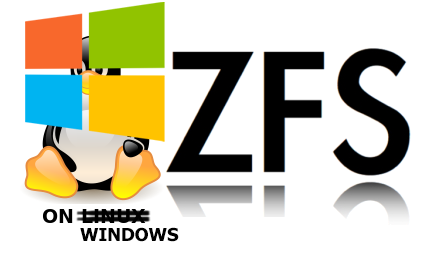ZFSin: working with ZFS natively under Windows

Doing a search on Habra in the word ZFS, I found almost fifty articles anyway mentioning a wonderful file system with that name. Separately, for example, we can mention the rather recent material “ ZFS on Linux: News from the Field 2017 ” and “ ZFS - the best file system (for now) ”. I made this search query here, that's why ...
For over 7 years, people have been wondering, " how do I get access to ZFS from Windows? " And about 6 years of sane and practical answer to this question did not exist. It's not even about performance, the very possibility of even natively reading data in Windows from volumes formatted with the ZFS file system excites the brain of many techies and system administrators. Then one day one enthusiast decided to change the sad state of affairs with the lack of support for ZFS in the most popular consumer desktop OS. It is strange only that for the year this news has not yet reached Habr. I think it's worth fixing it.
And so meet - ZFSin , the native full-featured ZFS file system driver for Windows. Source codes licensed under the Common Development and Distribution License (CDDL) . The driver is in alpha stage and is not suitable for production environments, but already can do a lot.
')
RomanStrlcpy found a video from OpenZFS Summit 2017, where ZFSin was introduced:
When the driver project was only published on GitHub, it was not yet clear how serious the developer’s intentions were and how far he was ready to go in developing the driver’s capabilities. Initially, the driver was distributed only in the form of source texts and was only suitable for debugging experiments. To do this, the author offered to download and run two virtual machines , in one of which there was a compilation and a driver deployment in the second - a test (target) virtual machine with a test pool ZFS.
Current progress in driver functionality at the time of the end of May 2018:

Now, after a year after the initial publication, the developer has demonstrated intentions to develop the project, the driver's functionality has been expanded, the stability has increased, so the possibility of distributing binary assemblies in the form of a driver has appeared. Although this is not explicitly stated, at the moment binary ZFSin assemblies are compatible only with Windows 10 x64 , however, the ability to generate 32-bit builds has recently been returned to the source code, and the author did not rule out the possibility of adding support for older versions of Windows.
Install binary release:
- Download and unzip the latest driver release.
- Disable driver digital signature verification (for example, bcdedit.exe -set testsigning on ) and reboot
- Run CMD with Administrator rights
- Run ZFSinstall.bat
- Choose “continue installation anyway” in the “unknown publisher” popup window
- Run the "zpool.exe status" command to check the status of the driver.
If the installation is successful, then after the last item you will see the message " No pools available ", if an error occurs, the message will be " Unable to open \\. \ ZFS: No error. "
The driver command syntax basically corresponds to that of the Open ZFS documentation. For compatibility reasons, case-insensitive file system mode should be used.
# zpool create [options] tank disk
-
# zpool create [options] tank mirror disk1 disk2
- ("raid1")
# zpool create [options] tank raidz disk1 disk2 disk3 .... diskn
- raidz ("raid5")
zpool create -O casesensitivity=insensitive -O compression=lz4 -O atime=off -o ashift=12 tank disk
- Windows
I would very much like to attract more attention of other programmers to this project, which the project certainly deserves. The developer of the ZFSin driver will be very pleased with your bug reports, pull requests, or at worst, asterisks that you send to his GitHub repository .
UPD The developer went to meet the requests and began publishing a 32-bit binary version of the driver.
Source: https://habr.com/ru/post/374317/
All Articles